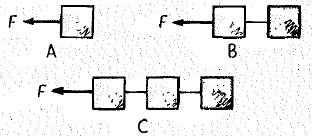
Concept explainers
Each of these boxes is pulled by the same force F to the left. All boxes have the same mass and slide on a friction-free surface.

Rank the following from greatest to least.
a. the acceleration of the boxes
b. the tension in the rope connected to the boxes on the right in B and in C
(a)
The rank of the acceleration of the boxes from greatest to least.
Answer to Problem 23A
The rank of the acceleration of the boxes from greatest to least is
Explanation of Solution
Introduction:
The expression for Newton’s second law of acceleration as follows:
Here,
Sketch the Free Body diagram of the forces acting on the system as shown in Figure.

Refer to Figure.
The acceleration of box A as follows:
The acceleration of box B as follows:
The acceleration of box C as follows:
Conclusion:
Thus, the rank of the acceleration of the boxes from greatest to least is
(b)
The rank of the tension in the rope connected to the boxes on the right in B and in C from greatest to least.
Answer to Problem 23A
The rank of the tension in the rope connected to the boxes on the right in B and in C from greatest to least from greatest to least is
Explanation of Solution
Sketch the Free Body diagram of the tension in the rope connected to the boxes on the right in B and in C as shown in Figure.

Refer to Figure.
The tension in the rope connected to the boxes on the right in B as follows
The tension in the rope connected to the boxes on the right in C as follows
Conclusion:
Thus, the rank of the tension in the rope connected to the boxes on the right in B and in C from greatest to least from greatest to least is
Chapter 7 Solutions
Conceptual Physics: The High School Physics Program
Additional Science Textbook Solutions
Human Anatomy & Physiology (2nd Edition)
Applications and Investigations in Earth Science (9th Edition)
Organic Chemistry (8th Edition)
Human Physiology: An Integrated Approach (8th Edition)
Chemistry: An Introduction to General, Organic, and Biological Chemistry (13th Edition)
Campbell Biology: Concepts & Connections (9th Edition)
- I need correct answer not chatgptarrow_forwardWhat is the resistance (in (2) of a 27.5 m long piece of 17 gauge copper wire having a 1.150 mm diameter? 0.445 ΧΩarrow_forwardFind the ratio of the diameter of silver to iron wire, if they have the same resistance per unit length (as they might in household wiring). d. Ag dFe = 2.47 ×arrow_forward
- Find the ratio of the diameter of silver to iron wire, if they have the same resistance per unit length (as they might in household wiring). d Ag = 2.51 dFe ×arrow_forwardShow that the units 1 v2/Q = 1 W, as implied by the equation P = V²/R. Starting with the equation P = V²/R, we can get an expression for a watt in terms of voltage and resistance. The units for voltage, V, are equivalent to [? v2 v2 A, are equivalent to J/C ✓ X . Therefore, 1 = 1 = 1 A V1 J/s Ω V-A X = 1 W. . The units for resistance, Q, are equivalent to ? The units for current,arrow_forwardPlease solve and answer the question correctly please. Thank you!!arrow_forward
 College PhysicsPhysicsISBN:9781305952300Author:Raymond A. Serway, Chris VuillePublisher:Cengage Learning
College PhysicsPhysicsISBN:9781305952300Author:Raymond A. Serway, Chris VuillePublisher:Cengage Learning University Physics (14th Edition)PhysicsISBN:9780133969290Author:Hugh D. Young, Roger A. FreedmanPublisher:PEARSON
University Physics (14th Edition)PhysicsISBN:9780133969290Author:Hugh D. Young, Roger A. FreedmanPublisher:PEARSON Introduction To Quantum MechanicsPhysicsISBN:9781107189638Author:Griffiths, David J., Schroeter, Darrell F.Publisher:Cambridge University Press
Introduction To Quantum MechanicsPhysicsISBN:9781107189638Author:Griffiths, David J., Schroeter, Darrell F.Publisher:Cambridge University Press Physics for Scientists and EngineersPhysicsISBN:9781337553278Author:Raymond A. Serway, John W. JewettPublisher:Cengage Learning
Physics for Scientists and EngineersPhysicsISBN:9781337553278Author:Raymond A. Serway, John W. JewettPublisher:Cengage Learning Lecture- Tutorials for Introductory AstronomyPhysicsISBN:9780321820464Author:Edward E. Prather, Tim P. Slater, Jeff P. Adams, Gina BrissendenPublisher:Addison-Wesley
Lecture- Tutorials for Introductory AstronomyPhysicsISBN:9780321820464Author:Edward E. Prather, Tim P. Slater, Jeff P. Adams, Gina BrissendenPublisher:Addison-Wesley College Physics: A Strategic Approach (4th Editio...PhysicsISBN:9780134609034Author:Randall D. Knight (Professor Emeritus), Brian Jones, Stuart FieldPublisher:PEARSON
College Physics: A Strategic Approach (4th Editio...PhysicsISBN:9780134609034Author:Randall D. Knight (Professor Emeritus), Brian Jones, Stuart FieldPublisher:PEARSON





